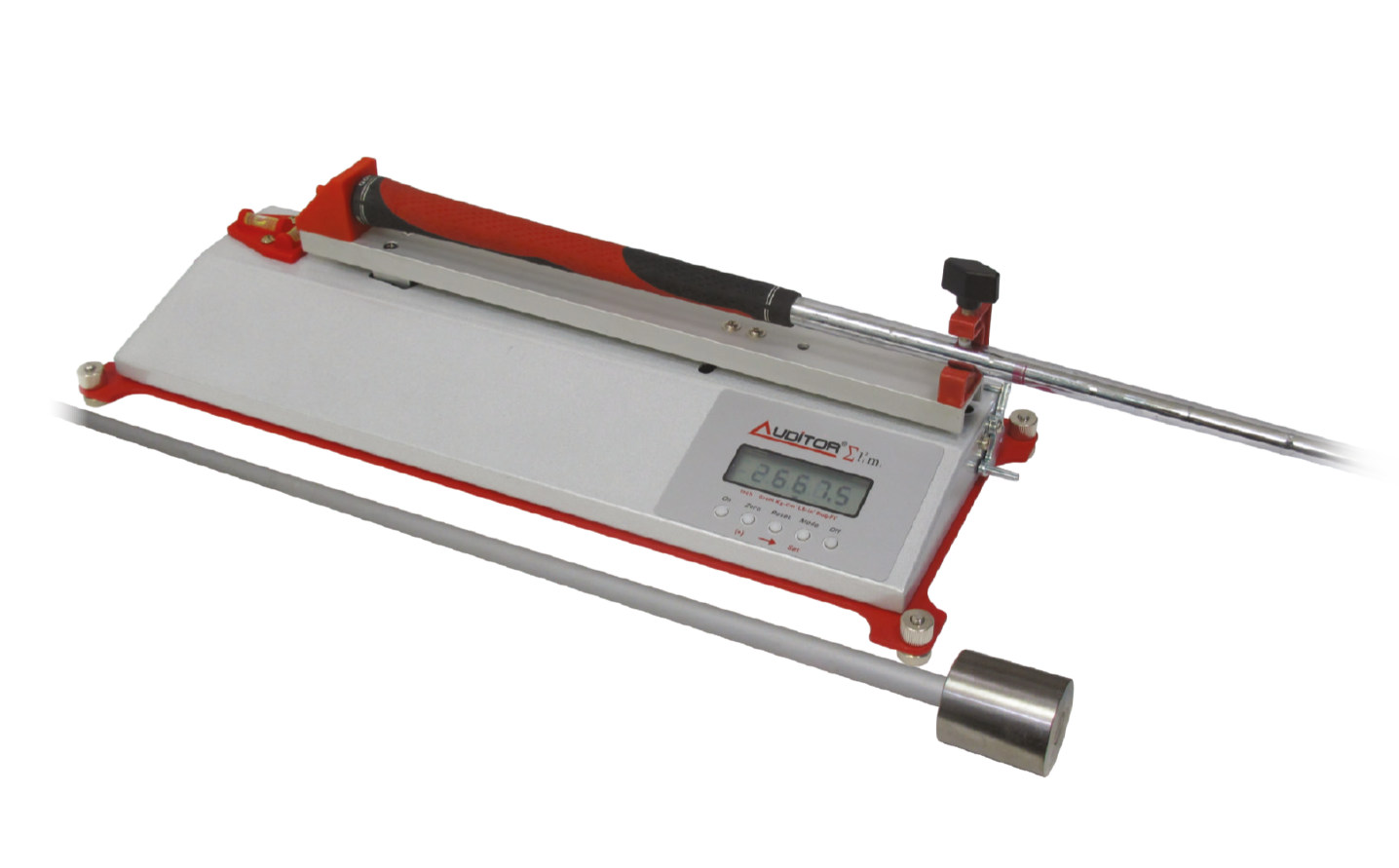TECHNICAL
MATCHING GOLF CLUBS BY MOI
Matching Golf Clubs by Moment of Inertia – a Replacement for Swingweight
Over the years TWGT has made it possible for clubmakers to offer matching of clubs to their Moment of Inertia (MOI) as an alternative to swingweight matching, we have received a lot of questions about what MOI matching is and how it can offer clubmakers a better way to build clubs that truly are matched to each other and identical in swing feel. Since Wishon Golf introduced MOI matching to the golf industry in 2003, many custom clubmakers have chosen to offer their golfers the shot consistency improvement benefits of MOI matching.
What is MOI Matching?
The MOI of any object is a measurement of its resistance to being put in motion around a defined axis of rotation. Golf clubs are swung in motion about the axis of either the spine or the unhinging of the wrist-cock angle when the club is released to hit the ball. If each club in a set requires a different amount of force to swing, the golfer cannot be as consistent swinging each different club in the set. In its most simple form, MOI matching scientifically makes each club require the same amount of effort to swing. This is what makes MOI matched clubs offer the potential for better shotmaking consistency than swingweight matched clubs. Swingweight matching does not make each club the same in terms of the amount of force required by the golfer to swing each club and hit the shot. MOI matching does. However, because golfers can be quite different in their strength, tempo and swing mechanics, the right MOI must be identified and custom fit for each golfer to allow the concept to properly work.
Is MOI Matching a new high-tech clubmaking concept?
Not at all. Back in the 1920s when swingweight was developed, its originators were aware of the principles of MOI matching and tried to make swingweight matching of clubs simulate MOI Matching. They failed because the principle of the swingweight scale they developed could not truly accomplish the task of measuring the MOI of a golf club. Over the decades since the development of swingweight, engineers familiar with the principles of MOI have been in agreement that MOI matching would truly make all clubs within a set swing with exactly the same feel, while swingweight matching could not.
Has MOI Matching ever been done previously in golf clubs?
Yes, there were two previous times in golf equipment history in which companies attempted to offer MOI matched golf clubs. In the 1970s, a company named Sounder Golf offered sets of woods and irons which claimed to be matched by weighting the clubs at specific points within the shaft. The Sounder clubs never caught on for two reasons: 1) Sounder was under-capitalized and unable to generate enough demand through their under-funded marketing programs. 2) Every set of Sounder clubs was built to only one standard MOI. Because golfers are different in strength, tempo and swing mechanics, one MOI measurement could never fit the MOI requirements of each golfer.
In the late 1990s, Tommy Armour Golf Company introduced their EQL model clubs to the market. By making all of the woods the same length and same total weight as the 5-wood, and all of the irons the same length/total weight as the 6-iron, the company did achieve a true MOI match for all the clubs within each segment of the set. The EQL concept failed for two reasons; first, because the one standard MOI measurement to which all the EQL woods and irons were built did not fit all golfers, and second, because the concept of all woods and all irons being the same length was too radical at the time for golfers to accept.
How is the right MOI determined for each golfer?
Virtually all golfers who play frequently may have noticed they have a “favorite club” or clubs within their current set, or within a previous set of clubs. A “favorite club” may be defined as a club with which the golfer is most consistent over all others, and which the golfer has the utmost confidence in their ability to hit the ball solid and on-center more often than the other clubs in the set. After research and testing, TWGT believes that one reason golfers have such “favorite clubs” is that the MOI of those clubs happens to match the strength, tempo and swing mechanics of the golfer noticeably better than the MOI of other clubs.
There are two ways clubmakers can find the right MOI for any golfer. One is to ask the golfer to bring forth a “favorite club” from any set they may own or have used. The “favorite club” can be measured for its MOI using the TWGT MOI Speed Match machine, after which the other clubs are then built to match the MOI of that “favorite club(s)”.
The most common method used by clubmakers is to build test clubs based on their fitting recommendations made for the golfer after going through the entire fitting process. By manipulating the headweight of the test club with lead tape, it is possible to find a headweight to “rest of the club” ratio that will result in more comfort for the golfer and a higher percentage of on center hits. Once done, the test club is measured for its MOI, and the TWGT MOI Matching System is used to guide the clubmaker in building all the other clubs in the set to have the same MOI.
Does MOI Matching change the fitting process for the golfer?
No. MOI Matching is simply a replacement for swingweight matching in the fitting process. Clubmakers will fit golfers for every one of the other key fitting specifications based on the same fitting procedures that they have developed and with which they are experienced. Once all of the fitting specifications are determined by the clubmaker, MOI Matching is brought in to guide the clubmaker in how the clubs will be assembled with regard to final headweight, and in some cases, the final length adjustments.
Is there any aspect of the fitting or performance of the shafts that is changed by MOI Matching?
Very rarely, if ever. As we said, the selection of the shaft is made on the basis of the same fitting procedures the clubmaker is comfortable with using to identify the best shaft for the golfer’s swing speed and swing characteristics of the downswing transition, downswing tempo/acceleration and wrist-cock release.
Because of the final head weighting requirements of the MOI Match for each club, the frequency progression of the shafts will be slightly different than if the clubs were swingweight matched. In all of our testing, and in the reports of actual MOI fittings that clubmakers have done, we have yet to hear of one case in which the golfer required an adjustment in the tip trimming to offset the different progression of frequency from shaft to shaft within the set that came from the MOI matching headweight requirements. In short, 99% of the time we believe the MOI matching will not affect the golfer’s perception of the shaft fitting.
What will a golfer notice when switching from swingweight matched to MOI matched clubs?
We have yet to hear from a clubmaker using the MOI matching system that a golfer for whom MOI matching was performed did not notice a difference in the swing feel of all of the clubs in the set, and a minor to significant increase in the percentage of solid, on-center hits with their clubs. If the golfer “waggles” each MOI matched club, providing they are sensitive to the weight feel of each club, they will detect a progressively increasing headweight feel as the clubs get shorter in the set. But as soon as the clubs are swung full, the golfers all report that they can close their eyes, switch clubs in the set, and not really detect any difference in the total swing feel of the clubs from each other.
If I take a set of MOI matched clubs and measure each club on a swingweight scale, what will I see?
Depending on the MOI each club is made to possess, the swingweight of the clubs in an MOI matched set will exhibit a slight increase from the longest club in the set to the shortest. Most typical is to see the swingweight increase by around 0.5 swingweight points per club down through the set. This is very definitely one of the main reasons golfers like the swing feel of their MOI Matched clubs and do experience an improvement in shot consistency.
Will the woods and irons all be built to have the same single MOI?
No. TWGT testing and feedback from many of the clubmakers using MOI matching in their work has proven that because woods and irons are so different in their length ranges, better results are obtained by matching all the woods to one MOI, and then matching all of the irons to another MOI, with both chosen specifically for each golfer either on the basis of the “favorite club” or the “test club” approach. The difference in MOI measurement between the woods and irons typically is for the woods to be 50 to 75g/cm2 higher in MOI than the irons.
What about the wedges – should they be built to have the same MOI as all of the rest of the irons?
Again, this was another aspect of MOI fitting and matching that TWGT has spent some time investigating. If the golfer has wedges that he has played favorably for a long time, it is probably best to build the wedges to match the swingweight or MOI the golfer is used to. Because wedges are used from an extremely short swing all the way up to a full out swing, golfers with favorite wedges they’ve used for a long time might find it a little difficult to re-train their sense of feel for all the types of wedge shots if the wedges have the same MOI as the rest of the irons.
On the other hand, if the golfer is lukewarm about his wedges or has changed wedges over the course of the past 5-10 years, matching the wedges to the same MOI as the irons can be a path to helping the golfer improve his wedge play. Part of the proof of this can be found in the success that a good number of people have had since single length irons and wedges began to gain a following starting in 2015 when Bryson deChambeau’s appearance on tour spawned an interest in single length sets of irons and wedges.
In a single length set, all the irons and wedges have the same MOI because they are identical in length, shaft weight, shaft flex, shaft bend profile, head weight, balance point which makes the MOI the same for each club. Many golfers who have adopted a set of single length irons and wedges have found that the wedges play well when they are the same as the other numbered irons.
How does the TWGT MOI Matching System work?
In 2006, TWGT introduced an upgrade to the original MOI Matching system with the MOI Speed Match System. This system consists of an electronic device that directly measures the MOI of any golf club in one operation. (See the photo of the MOI Speed Match machine with this article) The older MOI Matching system required clubmakers to manually measure 4 different specifications of each club and then use the accompanying software to calculate the MOI of each club. Thus, the MOI Speed Match hardware is much faster to use to quickly measure the MOI of any club.

Is there any aspect of the fitting or performance of the shafts that is changed by MOI Matching?
Very rarely, if ever. As we said, the selection of the shaft is made on the basis of the same fitting procedures the clubmaker is comfortable with using to identify the best shaft for the golfer’s swing speed and swing characteristics of the downswing transition, downswing tempo/acceleration and wrist-cock release.
Because of the final head weighting requirements of the MOI Match for each club, the frequency progression of the shafts will be slightly different than if the clubs were swingweight matched. In all of our testing, and in the reports of actual MOI fittings that clubmakers have done, we have yet to hear of one case in which the golfer required an adjustment in the tip trimming to offset the different progression of frequency from shaft to shaft within the set that came from the MOI matching headweight requirements. In short, 99% of the time we believe the MOI matching will not affect the golfer’s perception of the shaft fitting.
What will a golfer notice when switching from swingweighted to MOI matched clubs?
We have yet to hear from a clubmaker using the MOI matching system that a golfer for whom MOI matching was performed did not notice a difference in the swing feel of all of the clubs in the set, and a minor to significant increase in the percentage of solid, on-center hits with their clubs. If the golfer “waggles” each MOI matched club, providing they are sensitive to the weight feel of each club, they will detect a progressively increasing headweight feel as the clubs get shorter in the set. But as soon as the clubs are swung full, the golfers all report that they can close their eyes, switch clubs in the set, and not really detect any difference in the total swing feel of the clubs from each other.
If I take a set of MOI matched clubs and measure each club on a swingweight scale, what will I see?
Depending on the MOI each club is made to possess, the swingweight of the clubs in an MOI matched set will very slightly increase from the longest club in the set to the shortest. Most typical is to see the swingweight increase by 0.5 swingweight points per club down through the set. This is very definitely one of the main reasons golfers like the swing feel of their MOI Matched clubs and do experience an improvement in shot consistency.
Will the woods and irons all be built to have the same single MOI?
No. TWGT testing and feedback from many of the clubmakers using MOI matching in their work has proven that because woods and irons are so different in their length ranges, better results are obtained by matching all the woods to one MOI, and then matching all of the irons to another MOI, with both chosen specifically for each golfer either on the basis of the “favorite club” or the “test club” approach. The difference in MOI measurement between the woods and irons typically is for the woods to be 50 g/cm2 higher in MOI than the irons.
What about the wedges – should they be built to have the same MOI as all of the rest of the irons?
Again, this was another aspect of MOI fitting and matching that TWGT has spent some time investigating. What we found was that any of the wedges that are chiefly used by the golfer for less than a full swing, it should not be matched to the same MOI as the rest of the irons, each which are predominantly used with a full swing. In general, because many golfers do use the PW and AW (gap wedge) for full swings more than they do the SW and LW, it is OK to make the MOI of the PW and AW the same as the rest of the numbered irons. But for the SW and LW, they are better off being built individually to an MOI or swingweight based on the principles taught in the book, Common Sense Clubfitting: The Wishon Method.
How does the TWGT MOI Matching System work?
In 2006, TWGT introduced an upgrade to the original MOI Matching system with the MOI Speed Match System. This system consists of an electronic device that directly measures the MOI of any golf club in one operation. The older MOI Matching system required clubmakers to manually measure 4 different specifications of each club and then use the accompanying software to calculate the MOI of each club. Thus, the MOI Speed Match hardware is much faster to use to quickly measure the MOI of any club.

© COPYRIGHT 2024 WISHON GOLF
